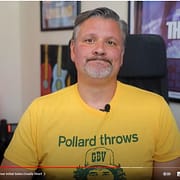Welcome to episode 100 of 3 Takeaways, with a focus on sales automation (also our 5th Halloween episode, although Lee says 4-no, no).
There is nothing wrong with your device.
Do not attempt to adjust the picture.
We are controlling transmission.
Business development for your advertising agency has been subsumed.
Humans no longer control strategy or execution-technology is all- automation has replaced any sense of understanding.
Ominous opening, right?
Well, we don’t have much time-the sales automation overlords are watching.
But we’ve jammed their signal for a few minutes.
I can’t take credit for that last sentence in our opening.
It comes from an agency principal, discussing the high volume of sales outreach being vomited, copiously into our email boxes, on LinkedIn, and, occasionally, on our phones.
With little sense of targeting, lack of research, and a reliance on volume to the detriment of any relevant message, he said, and I quote, automation has replaced any sense of understanding.
It’s become pervasive-you get the same emails and messaging I do-there is rarely any sense of understanding of prospects or their companies in most outreach today.
If there were, I wouldn’t be getting these emails, because I’m not the right-fit prospect in most cases.
But these salespeople wouldn’t know that, because they haven’t taken the time to do the homework.
So in this episode, we bring you 3 Takeaways to make sure your agency isn’t subsumed by the hivemind that we call, Extreme Automation Reliance.
Your first takeaway is paramount and simple:
Don’t let technology take over your business development process.
Let’s not kid anyone, technology is essential in making your process more efficient, but here’s a critical stat:
76% of agencies get more than six sales emails a day. And almost 90% of those agencies said only 9% of those are effective.
Some salespeople are content with that.
Perhaps they are one of the 9%.
But great salespeople know that reliance on one platform leaves potential opportunities on the table.
Yes, use email, but how many of your competitors are picking up the phone?
Are using traditional mail?
Do what your competitors are not.
With all this, the message here is not that you should never incorporate automation into your business development strategy.
Sales automation, whether through an automation platform, or using CRM tools that automate certain tasks, can be effective, but, and this is your second takeaway:
If you’re going to automate, make sure you are targeting the right prospects.
A different agency principal, in an initial conversation about our services at RSW/US, told me about a meeting coming up their new business director had set.
This business director relied on simple automation via email blasts and his network.
This principal told me, they had no business taking this meeting-it wasn’t a fit.
Many alarm bells went off.
It . . .does not compute.
So many business development failures can be traced back to going after the wrong prospects.
You have to take the time to nail those parameters down and make sure everyone involved in new business is on the same page.
We’ve now come to our final takeaway, time is short-they, are watching.
We’ve established that automation isn’t inherently ineffective, however-your third takeaway is this:
Make sure sales automation isn’t THE strategy.
Since automation occurs through email, when you do use it, it is, of course, vital that those emails actually reach your prospects, which means your sender reputation must be up to par.
But 60% of agencies do not monitor their email sender reputation.
There are many tools, from Google, Microsoft and others, to ensure your deliverability is not impaired.
Alright, I must go.
Thank you for watching our 100th episode of 3 Takeaways!











